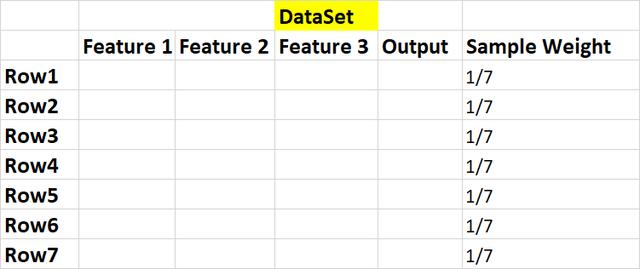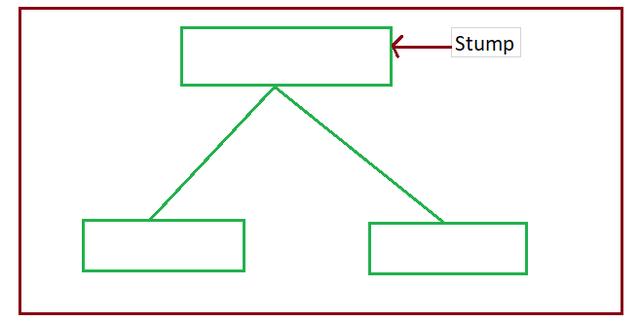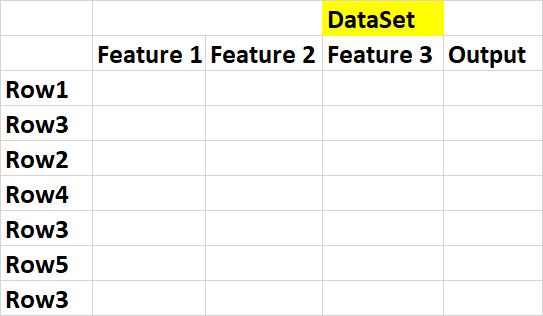數據科學:AdaBoost分類器
介紹:
- Boosting是一種集成技術,用于從多個弱分類器創建強分類器。 集成技術的一個眾所周知的例子是隨機森林(Random Forest),它使用多個決策樹來創建一個隨機森林。
直覺:
- AdaBoost,Adaptive Boosting的縮寫,是第一個成功的針對二進制分類開發的Boosting算法。它是一種監督式機器學習算法,用于提高任何機器學習算法的性能。 最好與像決策樹這樣的弱學習者一起使用。 這些模型在分類問題上的準確性要高于隨機機會。
AdaBoost的概念很簡單:
- 我們將把數據集傳遞給多個基礎學習者,每個基礎學習者將嘗試更正其前輩分類錯誤的記錄。
我們會將數據集(如下所示,所有行)傳遞給Base Learner1。所有被Base Learner 1誤分類的記錄(行5,6和7被錯誤分類)將被傳遞給Base Learner 2,類似地,所有Base分類器的錯誤分類記錄 學習者2將被傳遞給基本學習者3。最后,根據每個基本學習者的多數票,我們將對新記錄進行分類。

讓我們逐步了解AdaBoost分類器的實現:
步驟1:獲取數據集,并將初始權重分配給指定數據集中的所有樣本(行)。
W = 1 / n => 1/7,其中n是樣本數。

步驟2:我們將創建第一個基礎學習器。在AdaBoost中,我們將決策樹用作基礎學習器。這里要注意的是,我們將僅創建深度為1的決策樹,它們被稱為決策樹樁或樹樁。

我們將為數據集的每個特征創建一個樹樁,就像在我們的例子中,我們將創建三個樹樁,每個特征一個。
步驟3:我們需要根據每個特征的熵值或吉尼系數,選擇任何基礎學習器模型(為特征1創建的基礎學習器1,為特征2創建的基礎學習器2,為特征3創建的基礎學習器3) (我在決策樹文章中已經討論了Ginni和熵)。
熵或吉尼系數值最小的基礎學習器,我們將為第一個基礎學習器模型選擇該模型。
第4步:我們需要找到在第3步中選擇的基本學習者模型正確分類了多少條記錄以及錯誤分類了多少條記錄。
我們必須找到所有錯誤分類的總錯誤,讓我們說我們是否正確分類了4條記錄而錯誤分類了1條記錄
Total Error =分類錯誤的記錄的樣本權重的總和。
因為我們只有1個錯誤,所以總錯誤= 1/7
步驟5:通過以下公式檢查樹樁的性能。

當我們將Total Error放入該公式時,我們將得到0.895的值(不要偷懶地將這些值進行計算)
通過以下等式更新正確和錯誤分類的樣本(行)的樣本權重。
錯誤分類的樣本的新樣本權重=


正確分類的樣本的新樣本權重=



注意:我們假設第3行的分類不正確
步驟6:我們在這里考慮的要點是,當我們將所有樣本權重相加時,它等于1,但如果更新了權重,則總和不等于1。因此,我們將每個更新的權重除以總和,然后歸一化 值為1。
更新權重的總和是0.68

第7步:我們將通過刪除"樣品重量"和"更新重量"功能來創建數據集,并將每個樣品(行)分配到一個桶中。

步驟8:建立新的資料集。 為此,我們必須從0到1(對于每個樣本(行))中隨機選擇一個值,然后選擇該樣本,該樣本在" Bucket"下掉落,并將該樣本保留在" NEW DATASET"中。 由于分類錯誤的記錄具有較大的存儲桶大小,因此選擇該記錄的可能性非常高。

我們在這里可以看到,由于數據桶大小比其他行大,因此已在我們的數據集中選擇了3次錯誤分類的record(Row3)。
第9步:為下一個樹樁(基礎學習者2,基礎學習者3)獲取此新數據集,并按照步驟1至8進行所有功能。
Adaboost模型通過讓森林中的每棵樹對樣本進行分類來進行預測。然后,根據樹木的決策將它們分成幾組。現在,對于每組,我們對各樹中每棵樹的重要性進行累加。 整個森林的數量由總和最大的群體決定。下圖。

Adaboost分類器的逐步Python代碼:
- In [1]:
- #General idea behind boosting methods is to train predictors sequentially,each trying to correct its predecessor
- # AdaBoost Classifier Example In Python
- # Step 1: Initialize the sample weights
- # Step 2: Build a decision tree with each feature, classify the data and evaluate the result
- # Step 3: Calculate the significance of the tree in the final classification
- # Step 4: Update the sample weights so that the next decision tree will take the errors made by the preceding decision tree into account
- # Step 5: Form a new dataset
- # Step 6: Repeat steps 2 through 5 until the number of iterations equals the number specified by the hyperparameter (i.e. number of estimators)
- # Step 7: Use the forest of decision trees to make predictions on data outside of the training set
- In [2]:
- from sklearn.ensemble import AdaBoostClassifier
- from sklearn.tree import DecisionTreeClassifier
- from sklearn.datasets import load_breast_cancer
- import pandas as pd
- import numpy as np
- import seaborn as sns
- import matplotlib.pyplot as plt
- from sklearn.model_selection import train_test_split
- from sklearn.metrics import confusion_matrix,accuracy_score
- from sklearn.preprocessing import LabelEncoder
- import warnings
- warnings.filterwarnings('ignore')
- In [3]:
- cancer_data=load_breast_cancer()
- In [4]:
- X=pd.DataFrame(cancer_data.data,columns=cancer_data.feature_names)
- In [5]:
- y = pd.Categorical.from_codes(cancer_data.target, cancer_data.target_names)
- In [6]:
- #y=pd.DataFrame(y,columns=['Cancer_Target'])
- Data Preprocessing
- In [7]:
- X.describe()
- Out[7]:
- mean radius mean texture mean perimeter mean area mean smoothness mean compactness mean concavity mean concave points mean symmetry mean fractal dimension ... worst radius worst texture worst perimeter worst area worst smoothness worst compactness worst concavity worst concave points worst symmetry worst fractal dimension
- count 569.000000 569.000000 569.000000 569.000000 569.000000 569.000000 569.000000 569.000000 569.000000 569.000000 ... 569.000000 569.000000 569.000000 569.000000 569.000000 569.000000 569.000000 569.000000 569.000000 569.000000
- mean 14.127292 19.289649 91.969033 654.889104 0.096360 0.104341 0.088799 0.048919 0.181162 0.062798 ... 16.269190 25.677223 107.261213 880.583128 0.132369 0.254265 0.272188 0.114606 0.290076 0.083946
- std 3.524049 4.301036 24.298981 351.914129 0.014064 0.052813 0.079720 0.038803 0.027414 0.007060 ... 4.833242 6.146258 33.602542 569.356993 0.022832 0.157336 0.208624 0.065732 0.061867 0.018061
- min 6.981000 9.710000 43.790000 143.500000 0.052630 0.019380 0.000000 0.000000 0.106000 0.049960 ... 7.930000 12.020000 50.410000 185.200000 0.071170 0.027290 0.000000 0.000000 0.156500 0.055040
- 25% 11.700000 16.170000 75.170000 420.300000 0.086370 0.064920 0.029560 0.020310 0.161900 0.057700 ... 13.010000 21.080000 84.110000 515.300000 0.116600 0.147200 0.114500 0.064930 0.250400 0.071460
- 50% 13.370000 18.840000 86.240000 551.100000 0.095870 0.092630 0.061540 0.033500 0.179200 0.061540 ... 14.970000 25.410000 97.660000 686.500000 0.131300 0.211900 0.226700 0.099930 0.282200 0.080040
- 75% 15.780000 21.800000 104.100000 782.700000 0.105300 0.130400 0.130700 0.074000 0.195700 0.066120 ... 18.790000 29.720000 125.400000 1084.000000 0.146000 0.339100 0.382900 0.161400 0.317900 0.092080
- max 28.110000 39.280000 188.500000 2501.000000 0.163400 0.345400 0.426800 0.201200 0.304000 0.097440 ... 36.040000 49.540000 251.200000 4254.000000 0.222600 1.058000 1.252000 0.291000 0.663800 0.207500
- 8 rows × 30 columns
- In [8]:
- X.isnull().count()
- Out[8]:
- mean radius 569
- mean texture 569
- mean perimeter 569
- mean area 569
- mean smoothness 569
- mean compactness 569
- mean concavity 569
- mean concave points 569
- mean symmetry 569
- mean fractal dimension 569
- radius error 569
- texture error 569
- perimeter error 569
- area error 569
- smoothness error 569
- compactness error 569
- concavity error 569
- concave points error 569
- symmetry error 569
- fractal dimension error 569
- worst radius 569
- worst texture 569
- worst perimeter 569
- worst area 569
- worst smoothness 569
- worst compactness 569
- worst concavity 569
- worst concave points 569
- worst symmetry 569
- worst fractal dimension 569
- dtype: int64
- In [9]:
- def heatMap(df):
- #Create Correlation df
- corr = X.corr()
- #Plot figsize
- fig, ax = plt.subplots(figsize=(25, 25))
- #Generate Color Map
- colormap = sns.diverging_palette(220, 10, as_cmap=True)
- #Generate Heat Map, allow annotations and place floats in map
- sns.heatmap(corr, cmap=colormap, annot=True, fmt=".2f")
- #Apply xticks
- plt.xticks(range(len(corr.columns)), corr.columns);
- #Apply yticks
- plt.yticks(range(len(corr.columns)), corr.columns)
- #show plot
- plt.show()
- In [10]:
- heatMap(X)
- All the above correlated features can be dropped
- In [11]:
- X.boxplot(figsize=(10,15))
- Out[11]:
- <matplotlib.axes._subplots.AxesSubplot at 0x1e1a0eb7fd0>
- In [12]:
- le=LabelEncoder()
- In [13]:
- y=pd.Series(le.fit_transform(y))
- Data Split and Model Initialization
- In [14]:
- X_train,X_test,y_train,y_test=train_test_split(X,y,test_size=0.20,random_state=42)
- In [15]:
- adaboost=AdaBoostClassifier(DecisionTreeClassifier(max_depth=1),n_estimators=200)
- In [16]:
- adaboost.fit(X_train,y_train)
- Out[16]:
- AdaBoostClassifier(algorithm='SAMME.R',
- base_estimator=DecisionTreeClassifier(class_weight=None, criterion='gini', max_depth=1,
- max_features=None, max_leaf_nodes=None,
- min_impurity_decrease=0.0, min_impurity_split=None,
- min_samples_leaf=1, min_samples_split=2,
- min_weight_fraction_leaf=0.0, presort=False, random_state=None,
- splitter='best'),
- learning_rate=1.0, n_estimators=200, random_state=None)
- In [17]:
- adaboost.score(X_train,y_train)
- Out[17]:
- 1.0
- In [18]:
- adaboost.score(X_test,y_test)
- Out[18]:
- 0.9736842105263158
- In [19]:
- y_pred=adaboost.predict(X_test)
- In [20]:
- y_pred
- Out[20]:
- array([0, 1, 1, 0, 0, 1, 1, 1, 1, 0, 0, 1, 0, 1, 0, 1, 0, 0, 0, 1, 0, 0,
- 1, 0, 0, 0, 0, 0, 0, 1, 0, 0, 0, 0, 0, 0, 1, 0, 1, 0, 0, 1, 0, 0,
- 0, 0, 0, 0, 0, 0, 1, 1, 0, 0, 0, 0, 0, 1, 1, 0, 0, 1, 1, 0, 0, 0,
- 1, 1, 0, 0, 1, 1, 0, 1, 0, 0, 0, 0, 0, 0, 1, 0, 1, 1, 1, 1, 1, 1,
- 0, 0, 0, 0, 0, 0, 0, 0, 1, 1, 0, 1, 1, 0, 1, 1, 0, 0, 0, 1, 0, 0,
- 1, 0, 0, 1])
- Result Visualization
- In [21]:
- cm=confusion_matrix(y_test,y_pred)
- print('Confusion Matrix\n {} '.format(cm))
- Confusion Matrix
- [[70 1]
- [ 2 41]]
- In [22]:
- ax= plt.subplot()
- sns.heatmap(cm, annot=True, ax = ax);
- # labels, title and ticks
- ax.set_xlabel('Predicted labels');
- ax.set_ylabel('True labels');
- ax.set_title('Confusion Matrix');
- In [23]:
- acc=accuracy_score(y_test,y_pred)
- print('Model Accuracy is {} % '.format(round(acc,3)))
- Model Accuracy is 0.974 %
AdaBoost分類器的優點:
- AdaBoost可用于提高弱分類器的準確性,從而使其更靈活。 現在,它已擴展到二進制分類之外,并且還發現了文本和圖像分類中的用例。
- AdaBoost具有很高的精度。
- 不同的分類算法可以用作弱分類器。
缺點:
- 提升技巧是逐步學習的,確保您擁有高質量的數據非常重要。
- AdaBoost對噪聲數據和異常值也非常敏感,因此,如果您打算使用AdaBoost,則強烈建議消除它們。
- AdaBoost還被證明比XGBoost慢。
結論:在本文中,我們討論了理解AdaBoost算法的各種方法.AdaBoost就像是一個恩賜,如果正確使用它可以提高分類算法的準確性。
希望您喜歡我的文章。請鼓掌(最多50次),這會激發我寫更多的文章。






























